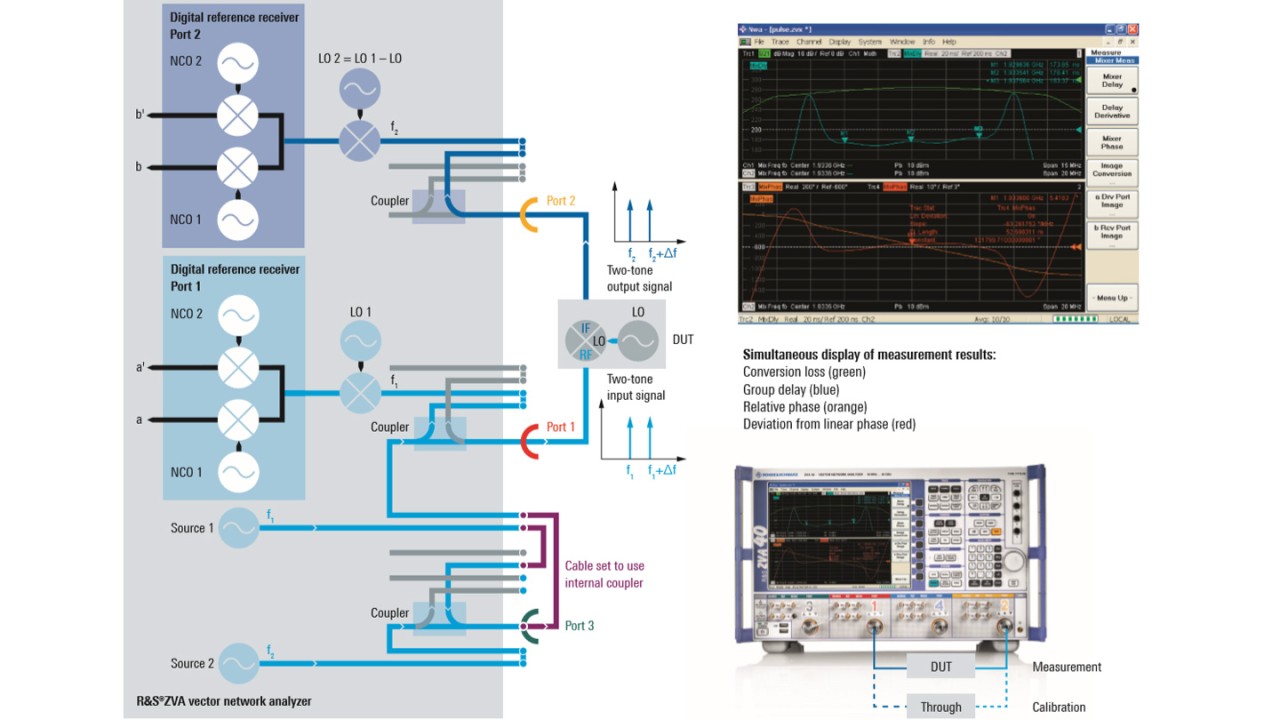R&S®ZVA-K9 Measure group delay without LO access
The R&S®ZVA vector network analyzer with the R&S®ZVA-K9 option enables absolute group delay measurements on devices with embedded LO without the need for a calibration mixer

The R&S®ZVA vector network analyzer with the R&S®ZVA-K9 option enables absolute group delay measurements on devices with embedded LO without the need for a calibration mixer
Mixers are one of the fundamental components of many receivers and transmitters, especially in the microwave range. Any mixer-based receiving or transmitting system requires that the mixers have well-controlled amplitude, group delay and phase responses. A linear phase and constant group delay in particular are essential for low bit error rates (BER) during data transmission in wireless and satellite communications systems and for high target resolution for phased array antenna modules in surveillance systems.
A key measurement is the relative or absolute group delay for frequency converters. If the local oscillator is accessible, group delay and relative phase can be measured using the reference mixer technique. Due to increasing integration and miniaturization, however, often neither the local oscillator (LO) nor a common reference frequency signal is accessible.


Digital frontend of the R&S®ZVA: Digital frontend of the R&S®ZVA to measure the phase difference of signals with different frequencies
Rohde & Schwarz has developed a novel technique to address this application. By using a two-tone stimulus signal the R&S®ZVA vector network analyzer can measure the phase difference between the two signals, both at the input and then at the output of the device under test (DUT). Comparable to the classic S-parameter technique, the group delay is calculated from the phase difference and the frequency offset. The frequency offset Δf between the two signals is the aperture. To measure the phase between two signals with different frequencies, Rohde & Schwarz has developed a unique frontend within the R&S®ZVA.
As the signal is passed into the ADC from each receiver (ax or bx), it is downconverted to DC by a digital local oscillator (NCO 1/2) in a digital mixer stage and then digitally filtered. Each receiver has two independent digital processing paths with the two NCOs presenting the same offset as the two RF signals of the two-tone stimulus signal. In each of the receiver frontends, the phase relationships of the two carriers can be determined and subsequently used for group delay calculation. This method works perfectly for frequency converting DUTs with unknown or unstable LOs since the frequency and phase deviations of the DUT’s internal LO are cancelled out when calculating the phase difference of the carriers.
In addition to group delay, the R&S®ZVA also calculates the relative phase and deviation from linear phase by integrating the group delay, and the derivative of the group delay by differentiating the group delay.
The R&S®ZVA-K9 embedded LO mixer delay measurements option is simple to set up with a 4-port R&S®ZVA. It uses the internal coupler of Port 3 as a combiner to provide the two-tone signal directly out of Port 1. The entire measurement is easily calibrated by connecting a known through connection between Ports 1 and 2 and normalizing out the cables in the same way as for standard S-parameters. This eliminates the need for known calibration mixers.
In many cases, group delay and relative phase measurements on frequency converting devices without LO access were only possible if the DUT had a highly stable internal LO. Phase and frequency deviations due to drift, phase noise or frequency modulation considerably limited the accuracy of available methods. The two-tone technique from Rohde & Schwarz overcomes all these limitations. The much easier calibration requiring only a through connection significantly simplifies the setup for this important measurement.


Configuration of measurement and calibration setup: The R&S®ZVA with the R&S®ZVA-K9 embedded LO mixer delay measurements option enables absolute group delay measurements on mixers and frequency converters, and is immune to phase or frequency instabilities of embedded LOs.